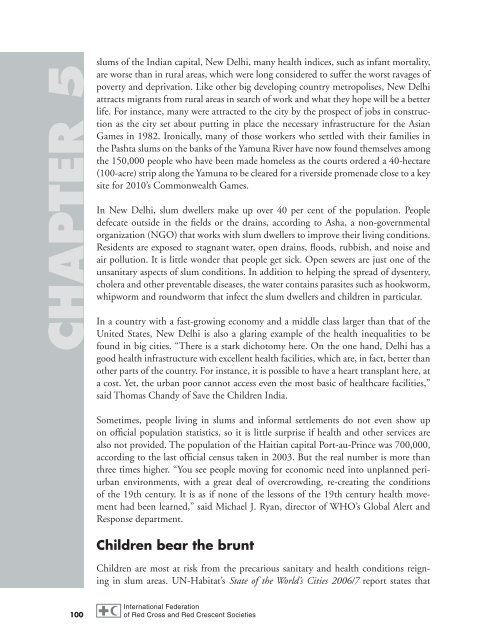World Disasters Report 2010 - International Federation of Red Cross ...
World Disasters Report 2010 - International Federation of Red Cross ...
World Disasters Report 2010 - International Federation of Red Cross ...
Create successful ePaper yourself
Turn your PDF publications into a flip-book with our unique Google optimized e-Paper software.
CHAPTER 5<br />
100<br />
slums <strong>of</strong> the Indian capital, New Delhi, many health indices, such as infant mortality,<br />
are worse than in rural areas, which were long considered to suffer the worst ravages <strong>of</strong><br />
poverty and deprivation. Like other big developing country metropolises, New Delhi<br />
attracts migrants from rural areas in search <strong>of</strong> work and what they hope will be a better<br />
life. For instance, many were attracted to the city by the prospect <strong>of</strong> jobs in construction<br />
as the city set about putting in place the necessary infrastructure for the Asian<br />
Games in 1982. Ironically, many <strong>of</strong> those workers who settled with their families in<br />
the Pashta slums on the banks <strong>of</strong> the Yamuna River have now found themselves among<br />
the 150,000 people who have been made homeless as the courts ordered a 40-hectare<br />
(100-acre) strip along the Yamuna to be cleared for a riverside promenade close to a key<br />
site for <strong>2010</strong>’s Commonwealth Games.<br />
In New Delhi, slum dwellers make up over 40 per cent <strong>of</strong> the population. People<br />
defecate outside in the fields or the drains, according to Asha, a non-governmental<br />
organization (NGO) that works with slum dwellers to improve their living conditions.<br />
Residents are exposed to stagnant water, open drains, floods, rubbish, and noise and<br />
air pollution. It is little wonder that people get sick. Open sewers are just one <strong>of</strong> the<br />
unsanitary aspects <strong>of</strong> slum conditions. In addition to helping the spread <strong>of</strong> dysentery,<br />
cholera and other preventable diseases, the water contains parasites such as hookworm,<br />
whipworm and roundworm that infect the slum dwellers and children in particular.<br />
In a country with a fast-growing economy and a middle class larger than that <strong>of</strong> the<br />
United States, New Delhi is also a glaring example <strong>of</strong> the health inequalities to be<br />
found in big cities. “There is a stark dichotomy here. On the one hand, Delhi has a<br />
good health infrastructure with excellent health facilities, which are, in fact, better than<br />
other parts <strong>of</strong> the country. For instance, it is possible to have a heart transplant here, at<br />
a cost. Yet, the urban poor cannot access even the most basic <strong>of</strong> healthcare facilities,”<br />
said Thomas Chandy <strong>of</strong> Save the Children India.<br />
Sometimes, people living in slums and informal settlements do not even show up<br />
on <strong>of</strong>ficial population statistics, so it is little surprise if health and other services are<br />
also not provided. The population <strong>of</strong> the Haitian capital Port-au-Prince was 700,000,<br />
according to the last <strong>of</strong>ficial census taken in 2003. But the real number is more than<br />
three times higher. “You see people moving for economic need into unplanned periurban<br />
environments, with a great deal <strong>of</strong> overcrowding, re-creating the conditions<br />
<strong>of</strong> the 19th century. It is as if none <strong>of</strong> the lessons <strong>of</strong> the 19th century health movement<br />
had been learned,” said Michael J. Ryan, director <strong>of</strong> WHO’s Global Alert and<br />
Response department.<br />
Children bear the brunt<br />
Children are most at risk from the precarious sanitary and health conditions reigning<br />
in slum areas. UN-Habitat’s State <strong>of</strong> the <strong>World</strong>’s Cities 2006/7 report states that

















